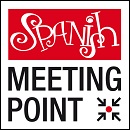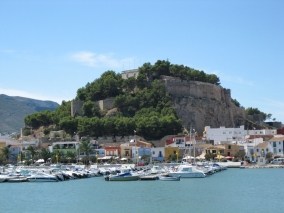Spanish schools and accommodation to study Spanish in Spain
Recent posts
Last schools
introduced
introduced
0 Accommodation

1 Spanish schools

Learning Spanish in Denia. The tourist guide to study your Spanish course.
If you decide to take Spanish lessons in this coastal town in Spain, you be delighted by its castle and old town. In addtion, learning Spanish in Denia, Alicante, is also recommended for those willing to enjoy Spanish sun!
General Information. 45,000 inhabitants, although in summer this number can increase significantly. 447 kilometres to the east of Madrid. Denia is located in the Autonomous Community of Valencia. It is the capital of Marina Alta, a coastal area in the northern part of the province of Alicante. From here it is easy to get to the Balearic Islands; Ibiza is only 105 kilometres away and is a very popular tourist destination. Denia enjoyed its moment of splendour during the reign of the Moors and it was even an independent city-state (Taifa) in the 11th century, becoming one of the most important in Spain. During this period it encompassed the whole of the Marina Alta, which at that time extended as far as Alicante, as well as parts of Murcia and the Balearic Islands. The official languages are Spanish and Valencian. Denia is a very attractive place to study Spanish with some language schools offering a wide range of courses.
Surrounding Areas. Beaches and cliffs; capes such as Cabo de San Antonio (12 kilometres) and Cabo de la Nao (20 kilometres); Montgó Nature Reserve (4 kilometres); caves (Cova Tallada, 5 kilometres); castles (Castillo de Moraira, 17 kilometres); the coastal town of Calpe (35 kilometres) and its rocky outcrop Ifach; Benidorm, a major tourist resort (53 kilometres); and the cities of Alicante (91 kilometres) and Valencia (106 kilometres).
World Heritage Site. La Cova de la Catxupa: the walls are covered in cave paintings dating back over 6,000 years.
Main Sights. You can find many examples of the different cultures that have left their mark in Denia, including numerous hermitages, historical fortifications such as the towers of Almadraba and Gerro, the castle and the old town, with its lovely fishermen's quarter which is nowadays full of bars, pavement cafés, boutiques and museums, each of which tells part of the story of this charming coastal enclave.
Culture. Festival Summer Jazz of Denia. Festival de Música al Castell, whose objective is to promote traditional and cultural music from all over the world. The many museums include the Museo Etnológico, situated in a typical 19th century bourgeois-style building and the Toy Museum, where you can see how the toy industry evolved from the beginning of the 20th century to the 1960s.
Beaches. These are among the great attractions of Denia. All have been classified by the European Union as being of high quality. There are beaches for everyone: urban beaches, small and secluded nudist beaches, beaches for windsurfing...In particular, Denia's beaches enjoy thermal winds in the afternoon thanks to their proximity to Mount Montgó and this has made them a windsurfers' paradise. The rocky coves of Les Rotes and the sea cliffs of Cape San Antonio have been declared a Marine Reserve, a protected area owing to their rich seabed. The beaches are a major attraction for the many students who decide to study Spanish in Denia.
Gastronomy. Denia is known as the gastronomic capital of the Costa Blanca. It is famous for its red shrimp and for its unbeatable arroz a banda (rice cooked in fish stock). Gastronomy contests involving many renowned chefs are organized to cook this rice dish. There are over 300 restaurants where you can sample Denia's typical dishes, most of them containing rice or fish, or where you can find assorted national and international recipes, including new trends in signature cuisine as represented by the prestigious Quique Dacosta restaurant. There are also bars specializing in tapas and these can be found between the old fishermen's quarter and the town centre. Other typical dishes in Denia are: pulpo con pencas (octopus with Swiss chard stems), llandeta (a seafood stew), erizos de mar (sea urchins), buñuelos de calabaza (pumpkin fritters) and coca María (traditional sponge cake)
Sports. The sports that deserve a special mention here are: windsurfing, kite-surfing, sailing, jet skiing, rowing, canoeing and diving, you can learn almost any of these sports here. Mountaineering and hiking are also popular, particularly in the Montgó Nature Reserve. There are several golf courses in the area, especially La Sella, next to the Hotel Marriot. The ‘Salt Route' (Ruta de la Sal), in the first fortnight of August, is a regatta in which the competing sailing boats set out from Barcelona and Denia and cross the finishing line in Ibiza.
Fiestas. This town is famous for its fiestas. The most noteworthy is Els bous a la mar (‘bulls to the sea'), which is considered to be an Event of National Tourist Interest and takes place during the first fortnight of July. During this fiesta, young people are chased through the streets of the town by a herd of bulls. The idea is to lead the bulls to a square which opens onto the seafront and both the youngsters and the bulls often end up in the water. Other important events are the Fallas (Bonfire Festivals) in the second fortnight of March and the Moros y Cristianos (‘Moors and Christians') in the first fortnight of August.
Transport. There is a tram that crosses the beaches and coastal towns and connects Denia to Alicante; it goes through such places as Altea and Benidorm. During the summer months, there is a tourist mini-train that takes you around the town, passing by the castle, the beaches, the coves, the port... It is easy to get from Denia to other Spanish cities by train or by using the various coach services.
Nightlife. Students who decide to study Spanish in Denia will discover a very active nightlife. Denia has a great nightlife, especially during the summer months. This is due to the pleasant temperatures, the cosmopolitan discotheques and pubs, and also thanks to the arrival of tourists who come here to spend their holidays. The most well-known area is La Marina, which has something to offer for everyone.
General Information. 45,000 inhabitants, although in summer this number can increase significantly. 447 kilometres to the east of Madrid. Denia is located in the Autonomous Community of Valencia. It is the capital of Marina Alta, a coastal area in the northern part of the province of Alicante. From here it is easy to get to the Balearic Islands; Ibiza is only 105 kilometres away and is a very popular tourist destination. Denia enjoyed its moment of splendour during the reign of the Moors and it was even an independent city-state (Taifa) in the 11th century, becoming one of the most important in Spain. During this period it encompassed the whole of the Marina Alta, which at that time extended as far as Alicante, as well as parts of Murcia and the Balearic Islands. The official languages are Spanish and Valencian. Denia is a very attractive place to study Spanish with some language schools offering a wide range of courses.
Surrounding Areas. Beaches and cliffs; capes such as Cabo de San Antonio (12 kilometres) and Cabo de la Nao (20 kilometres); Montgó Nature Reserve (4 kilometres); caves (Cova Tallada, 5 kilometres); castles (Castillo de Moraira, 17 kilometres); the coastal town of Calpe (35 kilometres) and its rocky outcrop Ifach; Benidorm, a major tourist resort (53 kilometres); and the cities of Alicante (91 kilometres) and Valencia (106 kilometres).
World Heritage Site. La Cova de la Catxupa: the walls are covered in cave paintings dating back over 6,000 years.
Main Sights. You can find many examples of the different cultures that have left their mark in Denia, including numerous hermitages, historical fortifications such as the towers of Almadraba and Gerro, the castle and the old town, with its lovely fishermen's quarter which is nowadays full of bars, pavement cafés, boutiques and museums, each of which tells part of the story of this charming coastal enclave.
Culture. Festival Summer Jazz of Denia. Festival de Música al Castell, whose objective is to promote traditional and cultural music from all over the world. The many museums include the Museo Etnológico, situated in a typical 19th century bourgeois-style building and the Toy Museum, where you can see how the toy industry evolved from the beginning of the 20th century to the 1960s.
Beaches. These are among the great attractions of Denia. All have been classified by the European Union as being of high quality. There are beaches for everyone: urban beaches, small and secluded nudist beaches, beaches for windsurfing...In particular, Denia's beaches enjoy thermal winds in the afternoon thanks to their proximity to Mount Montgó and this has made them a windsurfers' paradise. The rocky coves of Les Rotes and the sea cliffs of Cape San Antonio have been declared a Marine Reserve, a protected area owing to their rich seabed. The beaches are a major attraction for the many students who decide to study Spanish in Denia.
Gastronomy. Denia is known as the gastronomic capital of the Costa Blanca. It is famous for its red shrimp and for its unbeatable arroz a banda (rice cooked in fish stock). Gastronomy contests involving many renowned chefs are organized to cook this rice dish. There are over 300 restaurants where you can sample Denia's typical dishes, most of them containing rice or fish, or where you can find assorted national and international recipes, including new trends in signature cuisine as represented by the prestigious Quique Dacosta restaurant. There are also bars specializing in tapas and these can be found between the old fishermen's quarter and the town centre. Other typical dishes in Denia are: pulpo con pencas (octopus with Swiss chard stems), llandeta (a seafood stew), erizos de mar (sea urchins), buñuelos de calabaza (pumpkin fritters) and coca María (traditional sponge cake)
Sports. The sports that deserve a special mention here are: windsurfing, kite-surfing, sailing, jet skiing, rowing, canoeing and diving, you can learn almost any of these sports here. Mountaineering and hiking are also popular, particularly in the Montgó Nature Reserve. There are several golf courses in the area, especially La Sella, next to the Hotel Marriot. The ‘Salt Route' (Ruta de la Sal), in the first fortnight of August, is a regatta in which the competing sailing boats set out from Barcelona and Denia and cross the finishing line in Ibiza.
Fiestas. This town is famous for its fiestas. The most noteworthy is Els bous a la mar (‘bulls to the sea'), which is considered to be an Event of National Tourist Interest and takes place during the first fortnight of July. During this fiesta, young people are chased through the streets of the town by a herd of bulls. The idea is to lead the bulls to a square which opens onto the seafront and both the youngsters and the bulls often end up in the water. Other important events are the Fallas (Bonfire Festivals) in the second fortnight of March and the Moros y Cristianos (‘Moors and Christians') in the first fortnight of August.
Transport. There is a tram that crosses the beaches and coastal towns and connects Denia to Alicante; it goes through such places as Altea and Benidorm. During the summer months, there is a tourist mini-train that takes you around the town, passing by the castle, the beaches, the coves, the port... It is easy to get from Denia to other Spanish cities by train or by using the various coach services.
Nightlife. Students who decide to study Spanish in Denia will discover a very active nightlife. Denia has a great nightlife, especially during the summer months. This is due to the pleasant temperatures, the cosmopolitan discotheques and pubs, and also thanks to the arrival of tourists who come here to spend their holidays. The most well-known area is La Marina, which has something to offer for everyone.
© TEXT: SPANISH IN TOUR.
VIDEO: Ayuntamiento de Denia
VIDEO: Ayuntamiento de Denia
























